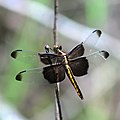| Male | Female | Scientific name | Common name | Distribution |
|---|
 |  | Libellula angelina Selys, 1883 | bekko tombo | North China, Japan |
 |  | Libellula auripennis Burmeister, 1839 | golden-winged skimmer | North and Central America |
 |  | Libellula axilena Westwood, 1837 | bar-winged skimmer | North America |
| | Libellula coahuiltecana Ortega-Salas & González-Soriano, 2015 | Coahuila Skimmer | Mexico (Coahuila) [5] |
|  | Libellula comanche Calvert, 1907 | Comanche skimmer | Central America and North America |
|  | Libellula composita (Hagen, 1873) | bleached skimmer | North America. |
 |  | Libellula croceipennis Selys, 1869 | neon skimmer | North and Central America |
 |  | Libellula cyanea Fabricius, 1775 | spangled skimmer | United States of America |
 |  | Libellula depressa Linnaeus, 1758 | broad-bodied chaser | Europe, West Asia. Sometimes included in the genus Ladona. |
 |  | Libellula flavida Rambur, 1842 | yellow-sided skimmer | North America |
| | Libellula foliata (Kirby, 1889) | | Mexico (Chiapas) |
 |  | Libellula forensis Hagen, 1861 | eight-spotted skimmer | Western United States and Canada |
 |  | Libellula fulva Müller, 1764 | scarce chaser | Europe |
| | Libellula gaigei Gloyd, 1938 | Red-mantled Skimmer | Mexico, United States(Texas) |
 |  | Libellula herculea Karsch, 1889 | Hercules Skimmer | Argentina, Bolivia, Brazil, Belize, Colombia, Costa Rica, Ecuador, French Guiana, Guatemala, Guyana, Honduras, Mexico, Nicaragua, Panama, Peru, Paraguay, El Salvador, and Venezuela |
 |  | Libellula incesta Hagen, 1861 | slaty skimmer | eastern United States and southern Ontario, Quebec, and New Brunswick. |
 | | Libellula jesseana Williamson, 1922 | purple skimmer | United States (Florida) |
 |  | Libellula luctuosa Burmeister, 1839 | widow skimmer | United States, Canada (southern Ontario and Quebec). |
| | Libellula mariae Garrison, 1992 | Maria's Skimmer | Costa Rica |
| | Libellula melli Schmidt, 1948 | | China |
 |  | Libellula needhami Westfall, 1943 | Needham's skimmer | Caribbean, Central America, and North America. |
|  | Libellula nodisticta Hagen, 1861 | hoary skimmer | Central America, North America, and South America. |
| | Libellula pontica Selys, 1887 | red chaser | Armenia, Iran, Iraq, Israel, Jordan, Kyrgyzstan, Syria, Turkey |
 |  | Libellula pulchella Drury, 1773 | twelve-spotted skimmer | southern Canada and contiguous U.S. states. |
 |  | Libellula quadrimaculata Linnaeus, 1758 | four-spotted skimmer or four-spotted chaser | Europe and North America |
 |  | Libellula saturata Uhler, 1857 | flame skimmer | Southwestern United States |
 |  | Libellula semifasciata Burmeister, 1839 | painted skimmer | New Brunswick, Canada as far south as Texas and Florida. |
 |  | Libellula vibrans Fabricius, 1793 | great blue skimmer | eastern United States |
|

















































